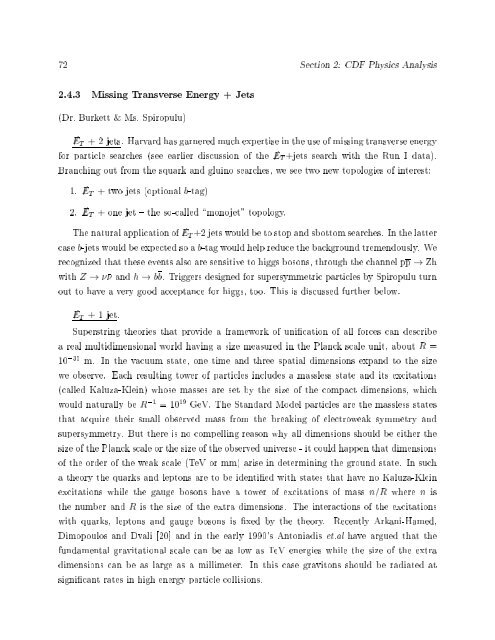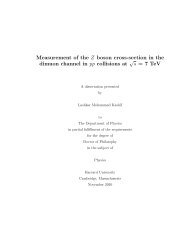2 The CDF Experiment at Fermilab Contents - Harvard University ...
2 The CDF Experiment at Fermilab Contents - Harvard University ...
2 The CDF Experiment at Fermilab Contents - Harvard University ...
Create successful ePaper yourself
Turn your PDF publications into a flip-book with our unique Google optimized e-Paper software.
72 Section 2: <strong>CDF</strong> Physics Analysis<br />
2.4.3 Missing Transverse Energy + Jets<br />
(Dr. Burkett & Ms. Spiropulu)<br />
6E T +2jets. <strong>Harvard</strong> has garnered much expertise in the use of missing transverse energy<br />
for particle searches (see earlier discussion of the 6E T +jets search with the Run I d<strong>at</strong>a).<br />
Branching out from the squark and gluino searches, we see two new topologies of interest:<br />
1. 6E T +two jets (optional b-tag)<br />
2. 6E T + one jet { the so-called \monojet" topology.<br />
<strong>The</strong> n<strong>at</strong>ural applic<strong>at</strong>ion of 6E T +2 jets would be to stop and sbottom searches. In the l<strong>at</strong>ter<br />
case b-jets would be expected so a b-tag would help reduce the background tremendously. We<br />
recognized th<strong>at</strong> these events also are sensitive to higgs bosons, through the channel pp ! Zh<br />
with Z ! and h ! bb. Triggers designed for supersymmetric particles by Spiropulu turn<br />
out to have avery good acceptance for higgs, too. This is discussed further below.<br />
6E T +1jet.<br />
Superstring theories th<strong>at</strong> provide a framework of unic<strong>at</strong>ion of all forces can describe<br />
a real multidimensional world having a size measured in the Planck scale unit, about R =<br />
10 ,35 m. In the vacuum st<strong>at</strong>e, one time and three sp<strong>at</strong>ial dimensions expand to the size<br />
we observe. Each resulting tower of particles includes a massless st<strong>at</strong>e and its excit<strong>at</strong>ions<br />
(called Kaluza-Klein) whose masses are set by the size of the compact dimensions, which<br />
would n<strong>at</strong>urally be R ,1 =10 19 GeV. <strong>The</strong> Standard Model particles are the massless st<strong>at</strong>es<br />
th<strong>at</strong> acquire their small observed mass from the breaking of electroweak symmetry and<br />
supersymmetry. But there is no compelling reason why all dimensions should be either the<br />
size of the Planck scale or the size of the observed universe - it could happen th<strong>at</strong> dimensions<br />
of the order of the weak scale (TeV or mm) arise in determining the ground st<strong>at</strong>e. In such<br />
a theory the quarks and leptons are to be identied with st<strong>at</strong>es th<strong>at</strong> have no Kaluza-Klein<br />
excit<strong>at</strong>ions while the gauge bosons have a tower of excit<strong>at</strong>ions of mass n=R where n is<br />
the number and R is the size of the extra dimensions. <strong>The</strong> interactions of the excit<strong>at</strong>ions<br />
with quarks, leptons and gauge bosons is xed by the theory. Recently Arkani-Hamed,<br />
Dimopoulos and Dvali [20] and in the early 1990's Antoniadis et.al have argued th<strong>at</strong> the<br />
fundamental gravit<strong>at</strong>ional scale can be as low as TeV energies while the size of the extra<br />
dimensions can be as large as a millimeter. In this case gravitons should be radi<strong>at</strong>ed <strong>at</strong><br />
signicant r<strong>at</strong>es in high energy particle collisions.















